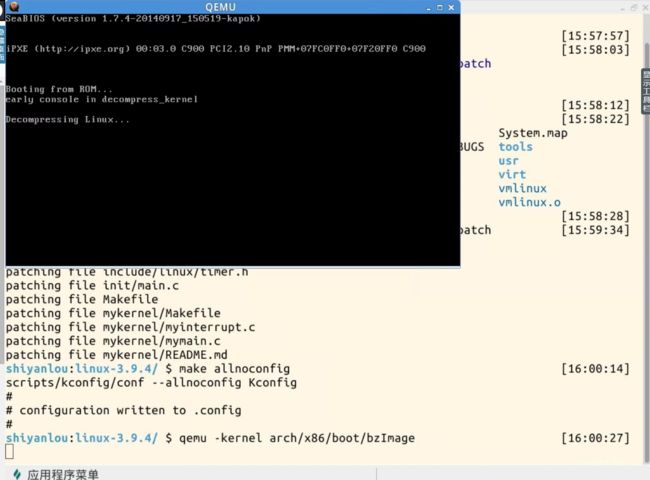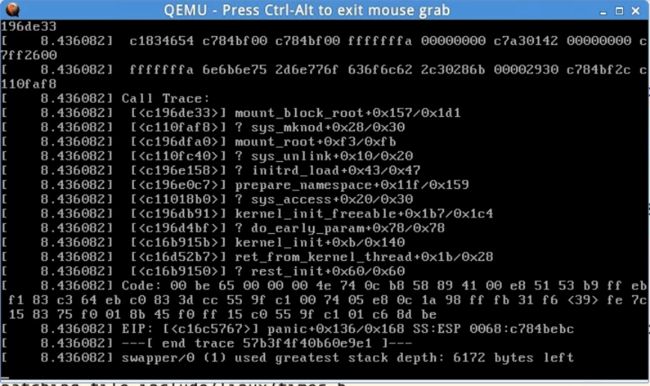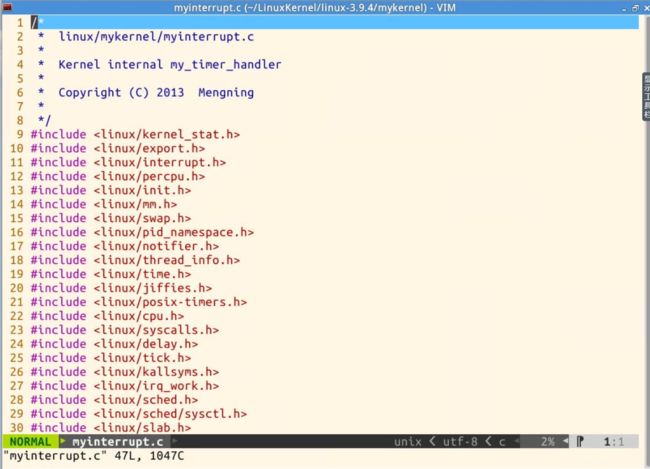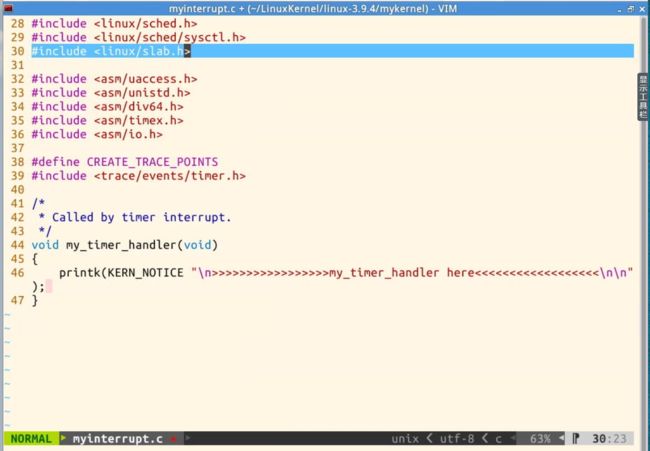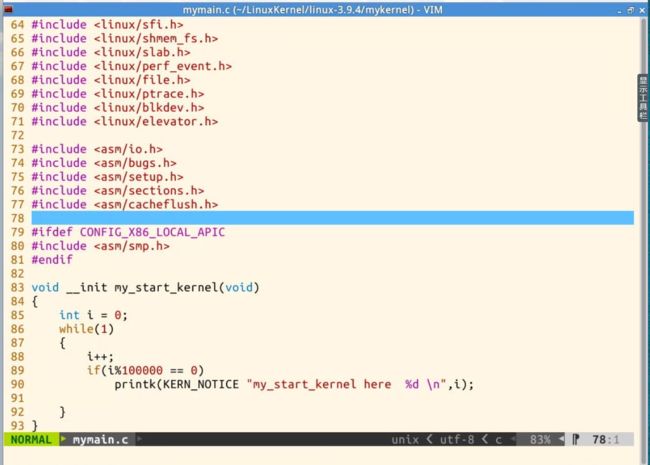实验:
首先,通过使用实验楼虚拟机shell搭建好虚拟x86平台
然后,查看myinterrupt.c代码
执行mytimerhandler每次时钟中断时调用一次,在中断处理时做中断操作
查看mymain.c代码
执行mystartkernel执行操作系统入口,循环在每100000次打印一次执行信息
构造一个简单的操作系统内核
mypcb.h
#define MAX_TASK_NUM 4
#define KERNEL_STACK_SIZE 1024*2 # unsigned long
/* CPU-specific state of this task */
struct Thread {
unsigned long ip;
unsigned long sp;
};
typedef struct PCB{
int pid;
volatile long state; /* -1 unrunnable, 0 runnable, >0 stopped */
unsigned long stack[KERNEL_STACK_SIZE];
/* CPU-specific state of this task */
struct Thread thread;
unsigned long task_entry;
struct PCB *next;
}tPCB;
void my_schedule(void);
分析:
在头文件中
-定义了两个变量,MAX_TASK_NUM最大任务数,和KERNEL_STACK_SIZE用来标栈空间大小
-定义了一个Tread结构,中有两个变量ip和sp,其功能是保护现场
-定义了一个PCB结构,即进程控制块,中有六个变量
--pid进程标识
--state状态,1为不可运行,0为可运行,>0为停止
--stack[KERNEL_STACK_SIZE]定义了一个和进程控制块自己的栈空间
--thread一个Tread结构
--task_entry一个任务入口点
--next为下一个PCB结构的指针
-最后定义了一个my_schedule函数
mymain.c代码
#include
#include
#include
#include
#include
#include "mypcb.h"
tPCB task[MAX_TASK_NUM];
tPCB * my_current_task = NULL;
volatile int my_need_sched = 0;
void my_process(void);
void __init my_start_kernel(void)
{
int pid = 0;
int i;
/* Initialize process 0*/
task[pid].pid = pid;
task[pid].state = 0;
/* -1 unrunnable, 0 runnable, >0 stopped */
task[pid].task_entry = task[pid].thread.ip = (unsigned long)my_process;
task[pid].thread.sp = (unsigned long)&task[pid].stack[KERNEL_STACK_SIZE-1];
task[pid].next = &task[pid];
/*fork more process */
for(i=1;ipid);
if(my_need_sched == 1)
{
my_need_sched = 0;
my_schedule();
}
printk(KERN_NOTICE "this is process %d +\n",my_current_task->pid);
}
}
}
分析:
-定义了一个最大任务数为大小的PCB结构数组
-my_current_task=NULL,用来指向当前PCB的指针
-my_need_sched=0,用来记录所需schedule数量
-定义了一个my_start_kernel函数
--首先对0号进程进行初始化,设置其标号、状态前后关系、和链表关系变量等
--然后用for循环对1号及其之后变量依次进行初始化以fork更多进程
--最后通过内嵌汇编代码开始运行0号进程块
---具体操作为将0进程中stread.sp值存入esp,当前代码地址入栈,保存现场
-定义了一个my_process函数
--用一个循环在操作控制台显示进程正在运行的信息
--也可以用来进行进程具体操作
myinterrupt.c
#include
#include
#include
#include
#include
#include "mypcb.h"
extern tPCB task[MAX_TASK_NUM];
extern tPCB * my_current_task;
extern volatile int my_need_sched;
volatile int time_count = 0;
/*
* Called by timer interrupt.
* it runs in the name of current running process,
* so it use kernel stack of current running process
*/
void my_timer_handler(void)
{
#if 1
if(time_count%1000 == 0 && my_need_sched != 1)
{
printk(KERN_NOTICE ">>>my_timer_handler here<<<\n");
my_need_sched = 1;
}
time_count ++ ;
#endif
return;
}
void my_schedule(void)
{
tPCB * next;
tPCB * prev;
if(my_current_task == NULL
|| my_current_task->next == NULL)
{
return;
}
printk(KERN_NOTICE ">>>my_schedule<<<\n");
/* schedule */
next = my_current_task->next;
prev = my_current_task;
if(next->state == 0)
/* -1 unrunnable, 0 runnable, >0 stopped */
{
my_current_task = next;
printk(KERN_NOTICE ">>>switch %d to %d<<<\n",prev->pid,next->pid);
/* switch to next process */
asm volatile(
"pushl %%ebp\n\t" /* save ebp */
"movl %%esp,%0\n\t" /* save esp */
"movl %2,%%esp\n\t" /* restore esp */
"movl $1f,%1\n\t" /* save eip */
"pushl %3\n\t"
"ret\n\t" /* restore eip */
"1:\t" /* next process start here */
"popl %%ebp\n\t"
: "=m" (prev->thread.sp),"=m" (prev->thread.ip)
: "m" (next->thread.sp),"m" (next->thread.ip)
);
}
return;
}
分析:
-定义了全局task[MAX_TASK_NUM]一个PCB数组
-定义了全局my_current_task一个PCB指针
-定义了全局整型my_need_sched
-定义了time_count = 0,一个计时器
-定义了一个my_time_handler函数
--该函数每隔1000ms产生一个中断,并置my_need_sched为1
--用来为my_process函数调用my_schedule函数创造机会
-定义了一个my_schedule函数
--首先定义两个PCB指针next和prev
--若此时没有当前需要执行的进程了,即返回
--开始设置next和prev指针
--此时开始判定条件
---如果next所指PCB的状态为0,则切换至next所指PCB开始执行
---如果next所指PCB状态不为0,则切换至一个新的PCB开始执行
---切换PCB执行的动作通过内嵌汇编代码来保存现场以便执行完成之后恢复现场
总结:
mypcb.h提供了时间片轮转进程控制块所需数据结构,mymain.c对进程进行初始化并提供了进程开始执行的入口,
myinterrupt.c产生中断信号并提供了进程管理的核心功能。
其中需要嵌入汇编代码来完成进程切换动作,说明中断保存现场工作需要由cpu和内核代码共同实现
王潇洋
《Linux内核分析》MOOC课程http://mooc.study.163.com/course/USTC-1000029000
